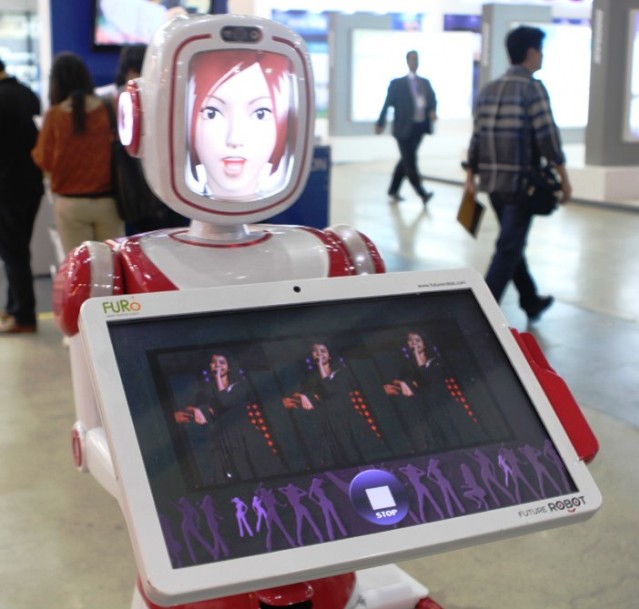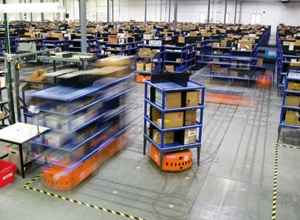December 2, 2014 – I bought a Roomba for my upcoming birthday.
A guy buying a robot vacuum cleaner? Yep!
I’m that much of a nerd to want to watch this little automaton cross my floors picking up the stray crumb that falls here and there. And while watching my Roomba, it goes by the name of Ruby, I began thinking about the relationship we humans have with robots, and what that relationship will be like as they get smarter and more versatile throughout this century.
I’m not the only futurist writing about the emergence of robots in our lives. Peter Diamandis in a recent email to me describes the stage we are going through with robots as a Cambrian explosion. If not familiar with the term “Cambrian,” it refers to a geologic age some 550 million years ago when complex life exploded on the scene in the world’s oceans. Before the Cambrian life was a lot simpler consisting of bacteria, single celled animals and multi-cellular colonies like stromatolites.
Ruby has onboard sensors. One detects obstacles in its path, notes navigation guides placed at the top of stairs or in front of my dog’s water and food bowls. One detects extra dirty spots. One adjusts the clearance to the type of flooring it is on, and one detects when the battery needs to be recharged and sends it back to its docking station.
Sensors are key to making robots experience the world around them and what used to cost thousands of dollars now can be had for less than $10 U.S. per sensor today with the price continuing to drop. Sensors are getting smaller to a point where they can be loaded on robot platforms to give them the ability to taste, smell, feel, see and hear just like we do and sometimes better. New image processing technology and 360 degree cameras let robots see even better than we do. Some robots can see light we cannot. Others are equipped to see in the absence of light.
Diamandis sees robots taking a part in every aspect of our lives. He describes drones that can send images to your smartphone and that cost as little as $50 U.S. He talks about autonomous vehicles, a subject for which I have recently written a new posting. He sees retail and warehousing robots (see Amazon’s robot-driven warehouse in the picture below) that can navigate and pick merchandise and interact with customers in natural language. He talks about security guards, butler and concierge bots. He imagines a world in which telepresence lets him visit his children during family meals even when he is on the road, or telecommute to offices and interact with staff virtually. He sees robotic surgeons, nurses and diagnosticians. And he predicts a time in the near future when we humans will rather deal with a robot than a person when seeking counsel or making critical decisions.
Diamandis doesn’t mention farmers and yet today we already are seeing robots in the fields, sowing, weeding, and harvesting, autonomously. He doesn’t mention mining. But robots are already displacing humans in mines where environmental conditions are far too dangerous.
And he doesn’t mention lawyers. Come to think of it, until artificial intelligence can convincingly argue a case against a human and convince a jury, I think lawyers may be safe for awhile from the coming of the robots. Although another futurist, Thomas Frey, Innovations Editor at The Futurist Magazine, where this blog also appears, and Senior Futurist at the DaVinci Institute, believes even lawyers will be at risk to the brain power of big data and artificial intelligence combined.
Frey writes about robots and a phenomenon he refers to as “technological unemployment.” In a recent article entitled “101 Endangered Jobs by 2030” he describes the jobs that will vanish to automatons and automation.
Frey doesn’t talk about the relationship we humans will have with robots as much as how they will replace us in many traditional jobs. So he doesn’t see us getting along with them in the 21st century if we drive a taxi, truck or bus. The driverless vehicle will simply be the replacement service. In the same way Frey sees assembly line workers, lumberjacks, farmers, landscapers, janitors, painters and many others no longer collecting a pay cheque as intelligent machines take over, capable of working day and night, 7 days a week, in facilities with or without lights, and in the outdoors in all kinds of conditions.
For much of humanity robots may be perceived as an existential 21st century threat. And like the Luddites who fought against the end of cottage industry as the Industrial Revolution emerged, a good percentage of us will find ourselves pushed to the employment sideline, or forced to go back to school to learn new skills. We will resist and many will migrate to the last places on the planet where robots have yet to enter the workforce and even then in time watch the automatons replace us as they get more capable and cheaper.
Of course someone will have to care for the robots. Someone will have to build them. Someone will have to write the code that governs their capability. But those jobs certainly do not make up for what will be lost.
In a Wired article by Marcus Wohlsen entitled, “When Robots Take All the Work, What’ll Be Left for Us to Do?” he describes a robot-powered world where scarcity is non-existent and where mass leisure may become the norm. This is a world where most of us will have a lot more time not working then working. Think about a 15-hour work week and maybe you begin to have a different appreciation of what robots can do for humanity. Of course for many, having too much time on hand is a lot scarier than going through the daily routine of a job.
A robot-powered world will be infinitely more productive than a human-labor powered one. A robot world may end the labour for money paradigm. In a Star Trekkian kind of way money may no longer measure success. In a robot-powered world humans who never contemplated it may turn into artists, philosophers, novelists, playwrights, musicians and inventors.
Wohlsen talks about our human sense of purpose and states, “by eliminating the need for people to work, robots would free us up to focus on what really makes us human.” He goes on, however, to suggest that for many of us it may be our work that defines us as human and that may prove to be the scariest of possibilities.














